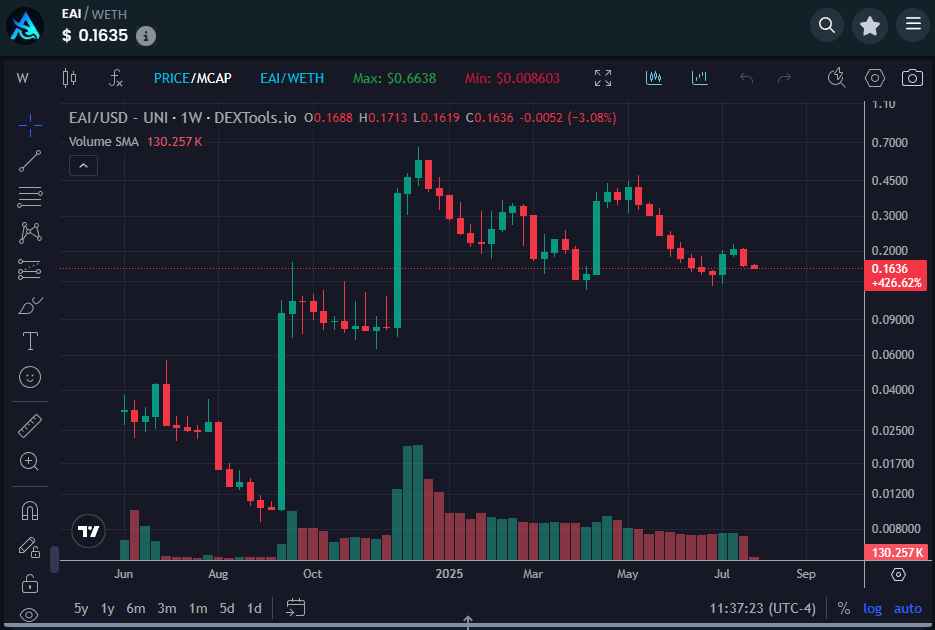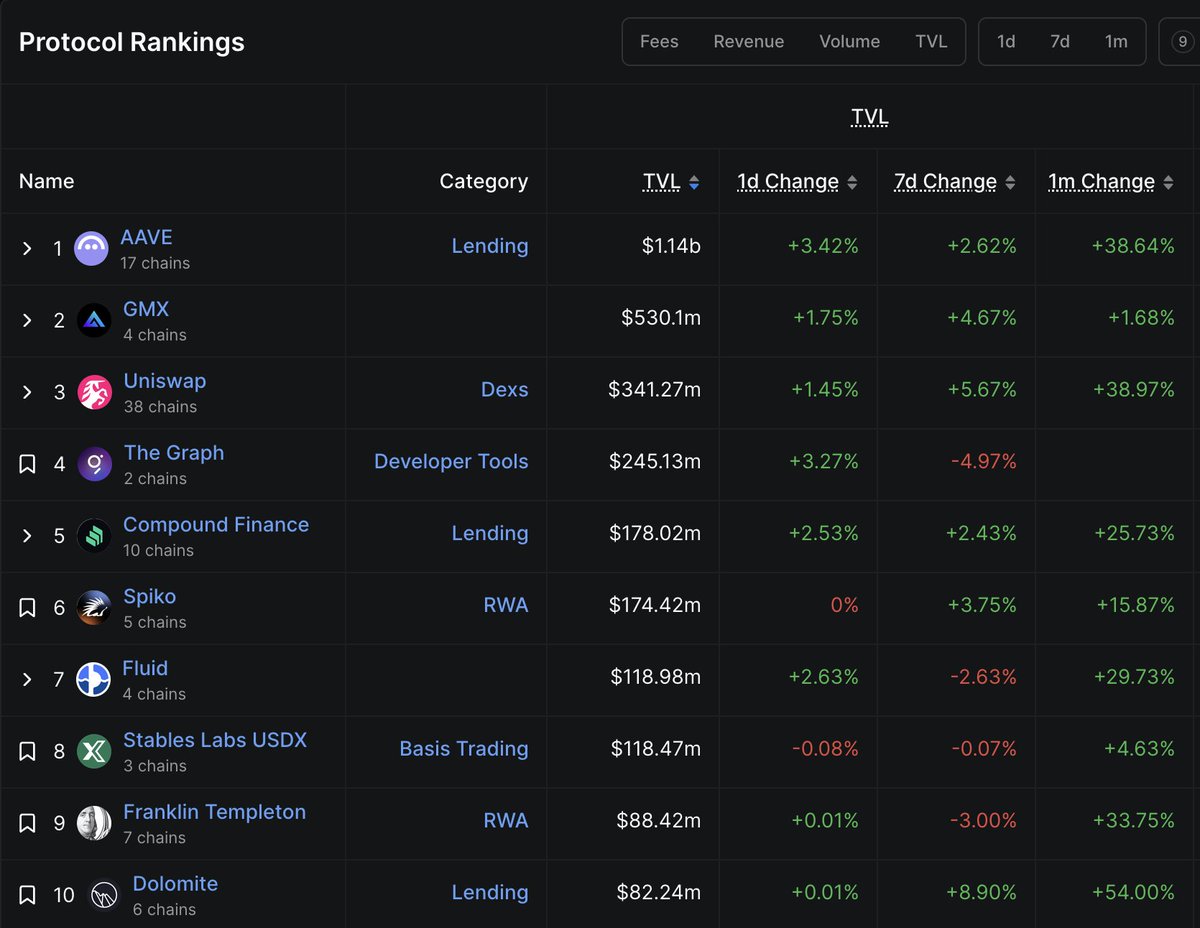Preț Uniswap
în USD

Despre Uniswap
Limitarea răspunderii
OKX nu furnizează recomandări privind investițiile sau activele. Trebuie să analizați cu atenție dacă să tranzacționați sau să dețineți activele digitale prin prisma stării dvs. financiare. Consultați-vă cu un profesionist în domeniul juridic / fiscal / de investiții pentru întrebări despre circumstanțele dumneavoastră specifice. Pentru detalii suplimentare, consultați Condițiile de utilizare și Avertizarea de risc. Prin utilizarea paginii web terțe („TPW”), acceptați că orice utilizare a unei TPW va fi supusă oricăror și guvernată de orice condiții pentru TPW. Exceptând mențiunile exprese în scris, OKX și afiliații săi („OKX”) nu sunt în niciun fel asociați cu proprietarul sau operatorul TPW. Sunteți de acord că OKX nu este responsabilă sau răspunzătoare pentru nicio pierdere, daună și orice alte consecințe care decurg din utilizarea de către dumneavoastră a unei TPW. Țineți cont că utilizarea TPW poate duce la pierderea sau diminuarea activelor dumneavoastră. Este posibil ca produsul să nu fie disponibil în toate jurisdicțiile.
Performanța prețului pentru Uniswap
Uniswap pe rețelele sociale



Ghiduri

Creați un cont de OKX gratuit.
Finanțați-vă contul.
Alegeți-vă cripto.
Întrebări frecvente Uniswap
Aflați mai multe despre Uniswap
Uniswap este o bursă descentralizată, denumită de obicei DEX, dezvoltată pe blockchainul Ethereum. Traderii folosesc Uniswap pentru aswap instant tokenuri ERC-20fără a necesita o piață lichidă de cumpărători, vânzători sau intermediari. Rețeaua prioritizează rezistența la cenzură, securitatea și autocustodia fără a avea nevoie de intermediari terți.
Spre deosebire de o bursă centralizată care procesează tranzacționările interne prin intermediul unui Registru de ordine, abursă descentralizată operează un ofertant pe piață automatizat (AMM), care funcționează ca un fond de lichidități constant, fără permisiuni, pe care traderii pot interacționa direct pe blockchain. UNI este tokenul nativ al protocolului Uniswap și este disponibil pentru tranzacționare pe diferite piețe pe OKX. UNI este necesar să voteze propunerile care guvernează dezvoltarea platformei Uniswap. Puteți folosi și UNI pentru a crea perechi de lichidități și a câștiga recompense cripto.
Ecosistemul Uniswap constă din următoarele caracteristici:
- Uniswap Labs: compania care a dezvoltat protocolul Uniswap.
- Protocolul Uniswap: o bursă cripto descentralizată pe blockchainul Ethereum.
- Interfața Uniswap: o interfață web care le permite utilizatorilor să interacționeze cu protocolul.
- Guvernanță Uniswap: un sistem de guvernanță care folosește tokenul UNI pentru a guverna protocolul Uniswap.
Deși a fost dezvoltat inițial pentru rețeaua Ethereum, Uniswap este acum operațional pePolygon,Arbitrum, și blockchainuri Optimism. Această flexibilitate blockchain încrucișat este unul dintre lucrurile pe care utilizatorii de finanțe descentralizate le adoră la Uniswap.
Cum funcționează Uniswap?
Uniswap este o platformă de bursă descentralizată care facilitează crearea unei varietăți enorme de fonduri de lichidități pe care traderii le pot folosi pentru a face swap cu tokenuri. Orice token compatibil poate fi adăugat la o bursă descentralizată și tranzacționat fără a fi necesară o entitate centralizată sau o companie pentru a găzdui bursa.
Pentru a activa acest lucru,Uniswap folosește contracte inteligente, un utilitar esențial în finanțele descentralizate, pentru a le permite traderilor să schimbe tokenuri printr-un ofertant pe piață automatizat. Un ofertant pe piață automatizat, ca Uniswap, este un mediu de schimb care le va permite traderilor să schimbe criptomonede în fonduri de lichidități pe blockchain prin intermediul aplicației web Uniswap. Atunci când utilizează Uniswap, utilizatorii nu sunt limitați de factori externi cum ar fi timpii de deschidere a pieței și necesitatea ca alți traderi să plaseze ordine corespunzătoare.
Pentru a crea un fond de lichidități, un furnizor de lichidități trebuie să furnizeze două tokenuri diferite care pot deveni o cantitate partajată de tokenuri cu care utilizatorii Uniswap pot tranzacționa. Prețul tokenurilor dintr-un anumit fond de lichidități este reglementat de o formulă matematică care dictează valoarea tokenurilor. Tranzacționarea cu un fond de lichidități modifică raportul tokenurilor din cadrul fondului, ducând la schimbări ale prețului fiecărui token.
Comisioanele de tranzacție stimulează furnizorii de lichidități să furnizeze tokenuri unui fond de lichidități Uniswap. Primiți un procent din fiecare tranzacție care tranzacționează tokenuri cu grupul.Aplicație descentralizată Uniswap (DApp)facilitează crearea unei varietăți enorme de fonduri de lichidități pe care traderii o pot folosi pentru a face swap cu tokenuri. Orice token compatibil poate fi adăugat la Uniswap și tranzacționat fără a fi necesară o entitate centralizată sau o afacere pentru a găzdui piața.
Prețul și tokenomia UNI
UNI este oToken ERC-20 cu ofertă în circulațiede aproximativ 734.000.000 și o cantitate maximă de geneza de 1.000.000 de tokenuri. Aceste tokenuri vor fi distribuite în următorii patru ani:
- Membrii comunității Uniswap: 60,00% (60.000.000 UNI).
- Angajați curenți și viitori angajați: 21,26% (1212.660.000 UNI).
- Investitori: 18,044% (180.440.000 UNI).
- Agenți de publicitate: 0,69% (290.000 UNI).
15% din oferta UNI totală a fost pusă imediat la dispoziția utilizatorilor istorici și furnizorilor de lichidități . Acest lucru a fost făcut pentru a recompensa membrii timpurii ai comunității pentru încrederea lor în rețea și lichidități. În plus, 43% din tokenurile UNI vor fi deținute de trezoreria de guvernanță Uniswap. Aceste 430.000.000 de tokenuri vor fi distribuite prin granturi din partea contributorilor, inițiative comunitare, minare de lichidități și alte programe.
Oferta UNI este inflaționistă, după o rată de 2%, începând cu patru ani după fabricarea tokenului. Acest model inflaționist asigură participarea continuă și contribuția la rețeaua Uniswap. Structura de emitere a Uniswap arată că oferta totală maximă va fi atinsă în 2024 septembrie.
Despre fondator
Dezvoltarea protocolului Uniswap a început în 2017 când fondatorul Hayden Adams a fost respins din poziția sa de inginer mecanic la Siemens. Adams l-a contactat pe prietenul său apropiat Karl Floersch pentru sfaturi, care i-a sugerat să afle mai multe despre Ethereum și contractele inteligente. Pentru a-și dezvolta abilitățile de cod și pentru a afla mai multe despre tehnologia blockchain, Adams a început să lucreze la un proiect careVitalik Buterin, fondatorul Ethereum, a fost descris pe Reddit, un forum online popular.
Adams a fost complet captivat de convingerea care a condus proiectul Ethereum. Misiunile de descentralizare și protocoale de permisiuni l-au determinat să continue dezvoltarea platformei Uniswap, deși a fost șomer la momentul respectiv. A avut loc o inovație cheie în luna aprilie 2018, când Adams a fost introdus în Vitalik Buterin la Conferința de Economie din Seoul. Buterin a citit codul sursă al lui Adam și l-a sfătuit să solicite o susținere din partea fundației Ethereum și să continue dezvoltarea Uniswap în Vyper, un limbaj de cod diferit.
După câteva luni de dezvoltare continuată, bursa descentralizată Uniswap a fost implementată în cele din urmă pe rețeaua principală Ethereum în noiembrie 2018. Totuși, echipa nu s-a oprit acolo și, până în ziua respectivă, continuă îmbunătățirea platformei cu actualizări frecvente. Un astfel de exemplu este nivelul opțional al comisioanelor de tranzacție din Uniswap V3. Acest lucru permite furnizorilor de lichidități să aleagă cât de mulți traderi trebuie să plătească în onorariile de tranzacție în timpul tranzacționării. În prezent, Uniswap deține cea mai mare valoare totală blocată (TVL) pentru orice bursă descentralizată pe Ethereum cel mai mare blockchain de contracte inteligente strat 1în industria criptomonedelor.
În calitate de pionier în domeniu, Uniswap a atras un interes semnificativ din partea mai multor investitori instituționali faimoși. Investitori mari ca Delphi Digital, Pantera Capital, a16z Crypto și Blockchain Capital au susținut și au finanțat Uniswap. Aceste fonduri experimentate au ajutat la dezvoltarea Uniswap și contribuie semnificativ la succesul curent.
Aspecte esențiale Uniswap
NFT-uri pe Uniswap
Una dintre cele mai interesante și discutate evoluții care vor fi disponibile pentru Uniswap este integrareaun agregator de tokenuri non-fungibile (NFT)pe platformă. În iunie 2022, Uniswaps Labs a anunțat că a achiziționat cu succes Genie și că îl va implementa în site-ul Uniswap.
Genie este un agregator de NFT-uri. Asta înseamnă că potențialii cumpărători de NFT-uri pot folosi Genie pentru a colecta și achiziționa NFT-uri listate pe orice piață într-un singur loc. Acest lucru simplifică procesul de colectare de NFT-uri și elimină necesitatea verificării mai multor burse diferite pentru cele mai bune oferte. Acesta este un pas masiv în dezvoltarea proiectului, ceea ce duce la interesul utilizatorilor DeFi și colecționarilor de NFT-uri față de Uniswap.
Widgetul swap
În aprilie 2022, dezvoltarea Uniswap a dezvăluit și implementat programul Swap Widget, o funcție de swap simplă pe care dezvoltatorii o pot integra ușor în aplicațiile lor. Widgetul Swap permite utilizatorilor să tranzacționeze tokenuri dintr-un site terț în loc să navigheze către aplicația web Uniswap. Widgetul Swap poate fi adăugat la o dApp compatibilă printr-o singură linie de cod și este deja utilizat de site-urile populare ca OpenSea.
Raportare privind gazele cu efect de seră




































